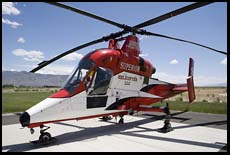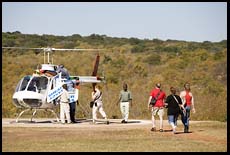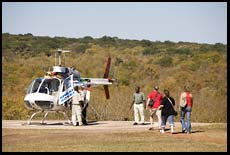

|
Preparing a Helicopter Landing Zoneby Philip Greenspun, CFI-H; September 2006 |
We once did sightseeing rides from the athletic fields at MIT to raise money for the MIT Flying Club. Briggs Field is the largest open space in Cambridge, Massachusetts. Several of the students on the ground organizing the event were certificated fixed-wing pilots and all had IQs above 140 plus $40,000 per year worth of education. Before the students set up the landing zone, you could have gotten an instrument trainer helicopter near Briggs Field, put on a hood, and blindly landed the thing in a random location and been perfectly safe. The MIT Flying Club folks, with the best of intentions, managed to create a dangerous environment from what had been perfect safety. How? We'd told them that the tail rotor was dangerous, so they constructed a temporary enclosure to keep people from walking into the tail. The enclosure was made with soccer goals, perfect for snagging the helicopter on approach or departure, and yellow caution tape, perfect for getting tangled up in the tail rotor or main rotor system.
This guide was written in response to that incident.
The helicopter should take off and land into the wind if possible, but never downwind. Helicopters fly more efficiently with a little bit of airspeed and if you take off into a 10-knot wind, you already have 10 knots of airspeed.
Wires and other obstacles are lethal to helicopter operations. The best landing zone is the center of a clear open field. A helicopter should not have to approach or depart over nearby wires. A Robinson helicopter needs to skim across the ground, with the skids between 5' and 10' over the surface, for about 100' before lifting higher.
Way In: Most folks think that helicopters take off and land straight up and down. Maybe they did at one time, but we live in an America that is increasing obese. When we're using helicopters and cranes to sling-load people who've grown too fat to fit through a door out of their apartments, the chance of getting a helicopter full of Americans straight up and down is remote. A normal approach in a helicopter is gliding down at a 10-degree angle. A steep approach is about 15 degrees. This means you need an area that is clear of obstacles, ideally the size of a football field unless the pilot is a hero and the helicopter is lightly loaded. The same consideration applies for the way out. The best shape for a landing zone, if you have several to choose amongst, is rectangular and oriented with the wind, i.e., a runway!
Helicopters can land on a slope, but it requires extra skill and entails some risk of dynamic rollover, which is a very common way to lose training helicopters. Try to pick an area that is flat. Dust, loose dirt, or snow on the surface is bad news; stuff that can blow around will blow around, possibly obscuring the pilot's vision once the helicopter comes to a hover. Paved is ideal. Grass is good.
A good way to mark the landing zone is with lime or paint. Heavyweight highway traffic cones may be used as well. Steal them from an Interstate Highway project; do not buy wimpy little ones that people might use to mark off a home driveway improvement project.
During all phases of the operation, including when the machine is shut down, keep the crowd away from the fragile tail rotor section and also from the fragile and expensive Plexi windows and bubble (people like to lean up against the helicopter with their synthetic clothing, especially for photos, and scratch the bubble).

